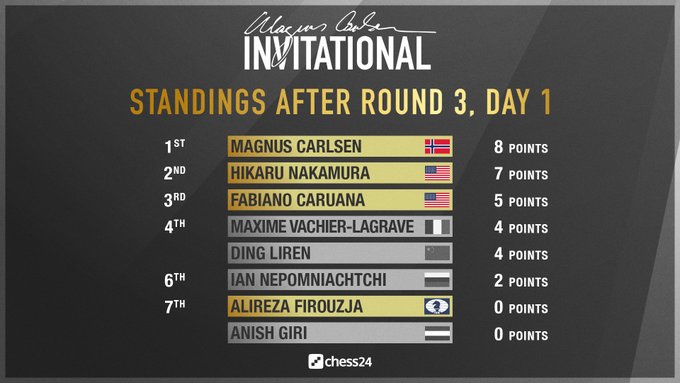


 It was an eventful day at the online Magnus Carlsen Invitational. The world champion came from showing some weak spots in his play and faced co-leader and world number two Fabiano Caruana. Carlsen surprised from the get go, opting for the Alekhine Defence — and winning — in game one. He went on to score a convincing win in the second encounter and cruised to match victory with two draws in the remaining contests. The Norwegian has won all three of his matches so far, two of them without needing tiebreaks.
It was an eventful day at the online Magnus Carlsen Invitational. The world champion came from showing some weak spots in his play and faced co-leader and world number two Fabiano Caruana. Carlsen surprised from the get go, opting for the Alekhine Defence — and winning — in game one. He went on to score a convincing win in the second encounter and cruised to match victory with two draws in the remaining contests. The Norwegian has won all three of his matches so far, two of them without needing tiebreaks.
Meanwhile, an unfortunate circumstance marked the match-up between Hikaru Nakamura and Alireza Firouzja. The latter had a better position in game one when, suddenly, his connection was lost, provoking his time to run out. It took a while for the commentators to announce the result of that game — the players were discussing the situation with the arbiters before finally agreeing to split the point.
Assertions can be made for three different ways to deal with this situation: to agree to a draw, to replay the game, or to give Nakamura the win after his opponent's disconnection. Given the nature of the tournament, a protocol should be established for these scenarios, and we expect the organizers of this and other similar events to take this into account. It is the first time a tournament of this calibre is played online though, so this will serve as a learning experience.
Nakamura went on to win game two after Firouzja cracked under pressure. In game three, the youngster's fighting spirit continued to shine, but, after losing his edge and reaching an equal endgame, he blundered and lost again. This series of misfortunes apparently took its toll on the 16-year-old, who spent no time on his clock before bungling his position as early as move 11 in game four and resigning three moves later.
It was a great victory for the world champion. In the post-game interview, he concluded, "Today was definitely my best day thus far". He kicked off with the black pieces, and employed the Alekhine Defence, later joking:
Carlsen: The first game I made one really, really bad move, and otherwise it was ok.
Peter Svidler: What move was that?
Carlsen: Well, 1...Nf6 wasn't really good (smiles).
He was actually talking about 23...c6. Caruana had sacrificed an exchange, trusting that his pair of bishops would give him enough counterplay. The plan was working out, as he was the one putting pressure. However, he started losing the thread on move 27, allowing Black to dangerously activate his rooks:
30.Kg1 was the only move that would have kept the game going, while Caruana's 30.Kg3 gave way to 30...R8d3 31.Qh6 Bxh3 and White is busted. Resignation came after 32.Kh4 Rxg2.
Game two saw Carlsen showing instructive technique to convert his bishop-pair advantage in a queenless position. That was also his fifth consecutive win with the white pieces of the event — in five attempts. Caruana got his best chances of the day in game three, but could not convert them into a full point, while the final encounter saw the world champion playing it safe and entering a good-looking drawing sequence to secure another half point.
A lot has been said about Carlsen's actual involvement in the organization and financing of the event. Tania Sachdev asked the Norwegian to talk about the subject. He used the chance to tease his friend Anish Giri:
The suggestion of four games [referring to the format], that's mine for sure. And, apart from that, I definitely had a say in who to invite — otherwise, our boy Anish might not have been part of the tournament (laughs).
Select an entry from the list to switch between games
Two of the biggest stars in the online-chess world were paired up against each other on Wednesday. Their match was unfortunately bumpy though, as Firouzja's internet connection was lost in the following position — the youngster was playing white:
Firouzja's time ran out and no one knew what was the official result of the game. It is true that the position gives white an advantage, but this is a position that can go either way, especially against a player as tricky in defence as Nakamura. After a while, the commentators announced a draw had been agreed between the players and the arbiters, but given the amount of time it took them to reach that decision we can speculate that not everyone was happy with the decision — we hope to be mistaken.
In game two, Nakamura, playing white, was the one putting pressure in a queenless position with four rooks on the board. Firouzja faltered on move 36 and the American got the first full point of the match shortly after.
Another fighting game followed, and this time it was Firouzja who was in the driver's seat:
White played the imprecise 56.Qe4 allowing 56...f5, when Black gets counterplay. Instead, he could have gone for 56.Be3 or 56.Kh4, keeping his queen on the dominant f5-square.
The real disaster for Firouzja came later though, as he blundered and lost in an endgame which would have been agreed a draw many moves earlier in a classical encounter:
Keeping the bishop in a diagonal from which it can easily defend the weakness on b4 would be enough to keep the balance here. Firouzja, however, continued with 71.Be7 Na6 72.Bg5 Nxb4, perhaps miscalculating some lines that would arise after 73.d7. As it happened, White played 73.Be3 and went on to lose the game twenty moves later.
Nakamura had already secured match victory, and an apparently distressed Firouzja lost the final game in merely 14 moves.
Select an entry from the list to switch between games

GM Daniel King analysed the games of day five
The Magnus Carlsen Invitational is brought to you by chess24.com. Learn more about the tournament at magnuscarlsen.com/en/invitational